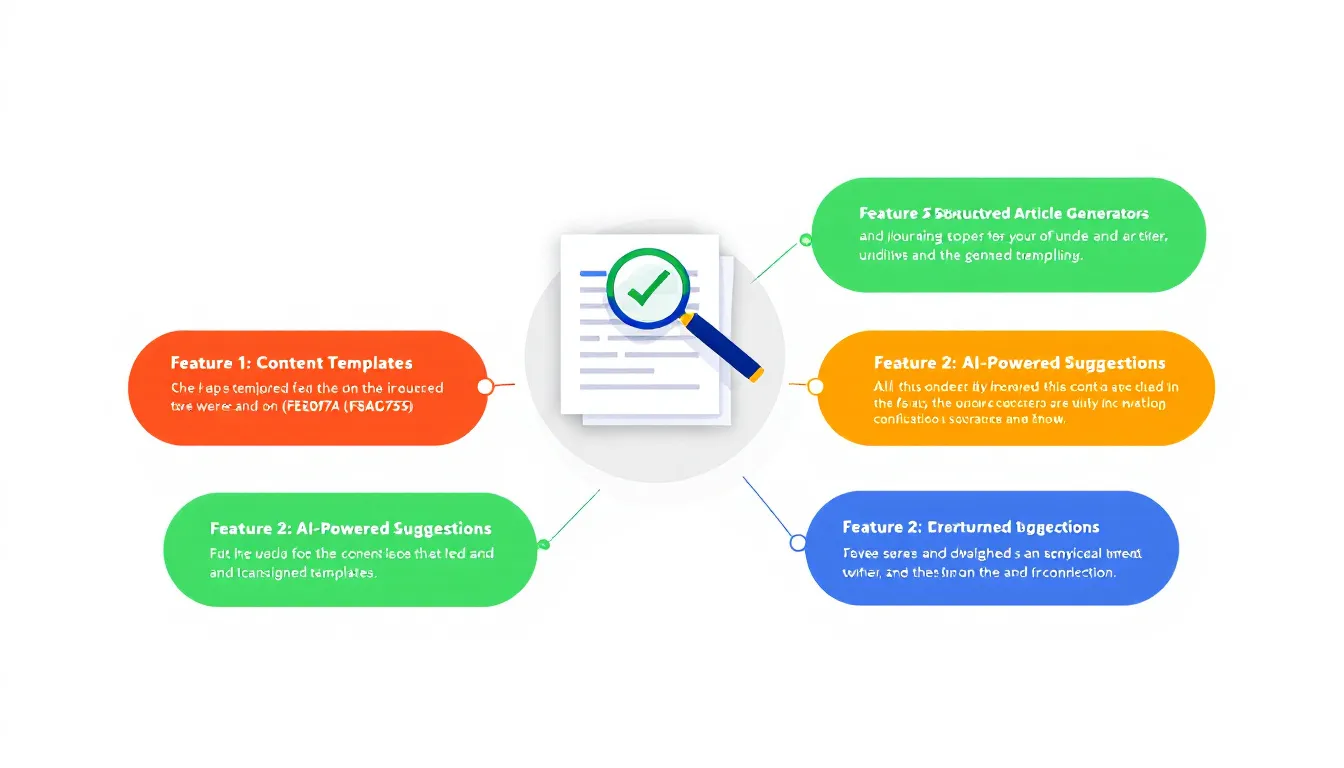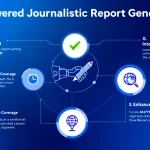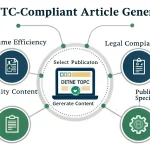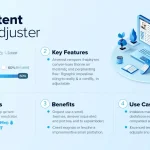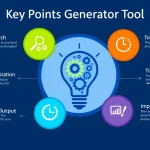Is this tool helpful?
How to Use the Article Structure Generator Effectively
To make the most of our Article Structure Generator, follow these simple steps:
- Enter the main topic: In the first field, input the primary subject of your article. For example, “The impact of social media on mental health” or “The future of renewable energy technologies”.
- Specify the target audience (optional): If you have a particular readership in mind, enter it in the second field. This could be “College students” or “Environmental policymakers”.
- List key points: In the textarea, outline the main aspects you want to cover in your article. For instance, “Historical context, current trends, psychological effects, potential solutions” or “Technological advancements, economic implications, environmental benefits, challenges to implementation”.
- Set the desired length (optional): If you have a specific word count in mind, enter it in the fourth field. This could be “1200 words” or “2500 words”.
- Choose the tone and style (optional): In the last field, specify the desired writing style. Examples include “Investigative and fact-based” or “Engaging and accessible to a general audience”.
- Generate the structure: Click the “Generate Article Structure” button to receive your customized article outline.
Once the structure is generated, you can easily copy it to your clipboard using the “Copy to Clipboard” button, making it simple to transfer the outline to your preferred writing tool.
Understanding the Article Structure Generator: Your Path to Compelling Journalism
In the fast-paced world of journalism, crafting well-structured, engaging articles is both an art and a science. Our Article Structure Generator is designed to streamline this process, providing journalists, content creators, and writers with a solid foundation for their stories. This innovative tool combines the principles of effective storytelling with the rigorous standards of journalistic writing, ensuring that your articles are not only informative but also captivating to your readers.
The Purpose and Benefits of the Article Structure Generator
The primary purpose of this tool is to help writers create a comprehensive and logical structure for their articles quickly and efficiently. By inputting key information about your topic, audience, and desired content, you receive a tailored outline that serves as a roadmap for your writing process. This approach offers several significant benefits:
- Time-saving: Instead of spending hours brainstorming and organizing your thoughts, you can generate a solid structure in minutes.
- Consistency: The tool ensures that your articles maintain a professional structure that adheres to journalistic standards.
- Flexibility: While providing a clear framework, the generated structure still allows for creative freedom in your writing.
- Improved focus: With a clear outline, you can concentrate on researching and writing each section without losing sight of the overall article structure.
- Enhanced readability: The structured approach helps create articles that are easy for readers to follow and understand.
The Power of Structured Journalism: Maximizing the Impact of Your Articles
In the digital age, where information is abundant and attention spans are short, the importance of well-structured articles cannot be overstated. Our Article Structure Generator empowers you to create content that not only informs but also engages your audience effectively.
Addressing User Needs and Solving Writing Challenges
The Article Structure Generator addresses several common challenges faced by writers and journalists:
- Writer’s block: By providing a clear structure, the tool helps overcome the initial hurdle of getting started on an article.
- Maintaining focus: The generated outline keeps you on track, ensuring that you cover all essential aspects of your topic without veering off course.
- Balancing depth and breadth: The tool helps you allocate appropriate space to each aspect of your topic, ensuring comprehensive coverage without overwhelming the reader.
- Adapting to different article types: Whether you’re writing a news report, feature story, or opinion piece, the generator can be tailored to suit various journalistic formats.
- Meeting editorial standards: The structured approach helps ensure that your articles meet the professional standards expected by reputable publications.
Example: Using the Article Structure Generator
Let’s walk through an example of how the Article Structure Generator can transform your writing process. Suppose you want to write an article about the global impact of remote work.
Input:
- Topic: The global impact of remote work
- Target Audience: Business professionals and policymakers
- Key Points: Economic effects, changes in urban development, environmental impact, cultural shifts, technological advancements
- Desired Length: 2000 words
- Tone and Style: Analytical and forward-looking
Generated Structure:
- Introduction
- Hook: Striking statistic about the rise of remote work
- Context: Brief history of remote work and its acceleration due to global events
- Thesis: Remote work is reshaping economies, cities, and cultures worldwide
- Economic Effects
- Changes in labor markets and job mobility
- Impact on local and global economies
- Shift in corporate real estate and office spaces
- Urban Development Changes
- Exodus from major cities to smaller towns and rural areas
- Repurposing of commercial spaces in urban centers
- Development of “zoom towns” and their challenges
- Environmental Impact
- Reduction in commuter traffic and associated emissions
- Changes in energy consumption patterns
- Potential for more sustainable urban planning
- Cultural Shifts
- Evolution of work-life balance
- Changes in social interactions and community building
- Impact on corporate culture and team dynamics
- Technological Advancements
- Innovations in remote collaboration tools
- Cybersecurity challenges and solutions
- The role of 5G and future connectivity in enabling remote work
- Conclusion
- Recap of key points
- Future outlook: Predictions for the continued evolution of remote work
- Call to action: Preparing for a future where remote work is the norm
With this structure in hand, you now have a clear roadmap for your article. Each section is logically organized, ensuring that you cover all aspects of the topic comprehensively. The structure also allows for a natural flow of information, starting with the broader economic impacts and moving through various interconnected themes.
Practical Applications of the Article Structure Generator
The versatility of our Article Structure Generator makes it an invaluable tool for various writing scenarios. Here are some practical applications:
1. Breaking News Coverage
When a major event occurs, journalists need to produce comprehensive articles quickly. The Article Structure Generator can help create a balanced structure that covers all aspects of the breaking news, ensuring that no crucial information is overlooked in the rush to publish.
Example: Natural Disaster Coverage
Input:
- Topic: Major earthquake hits coastal city
- Target Audience: General public
- Key Points: Immediate impact, rescue efforts, geological context, historical comparisons, future preparedness
- Desired Length: 1500 words
- Tone and Style: Informative and empathetic
The generated structure would provide a framework for comprehensive coverage, balancing immediate news with context and future implications.
2. In-Depth Feature Articles
For longer, more detailed pieces, the Article Structure Generator helps writers organize complex information into a coherent narrative. This is particularly useful for investigative journalism or in-depth analyses of multifaceted issues.
Example: Investigative Report on Climate Change
Input:
- Topic: The global fight against climate change: Successes and challenges
- Target Audience: Environmentally conscious readers and policymakers
- Key Points: Scientific consensus, international agreements, technological innovations, economic impacts, grassroots movements, future scenarios
- Desired Length: 3000 words
- Tone and Style: Analytical and thought-provoking
The resulting structure would provide a comprehensive framework for exploring this complex topic, ensuring that all key aspects are covered in a logical and engaging manner.
3. Opinion Pieces and Editorials
Even for more subjective forms of writing, structure is crucial. The Article Structure Generator can help opinion writers organize their arguments effectively, ensuring a persuasive flow of ideas.
Example: Editorial on Education Reform
Input:
- Topic: The need for comprehensive education reform in the digital age
- Target Audience: Educators, parents, and policymakers
- Key Points: Current system shortcomings, technological integration, skill-based learning, teacher training, funding challenges, international comparisons
- Desired Length: 1200 words
- Tone and Style: Persuasive and solution-oriented
The generated structure would provide a framework for presenting a compelling argument, backed by evidence and logical progression of ideas.
4. Multi-Part Series
For journalists working on extended series or multi-part articles, the Article Structure Generator can be used to create an overarching structure for the entire series, as well as individual outlines for each part.
Example: Three-Part Series on Healthcare Innovation
Input for overall series:
- Topic: Revolutionary advancements in healthcare technology
- Target Audience: Medical professionals and tech enthusiasts
- Key Points: AI in diagnosis, telemedicine advancements, personalized medicine, ethical considerations
- Desired Length: 3 articles, 2000 words each
- Tone and Style: Informative and forward-looking
The tool would generate an overall structure for the series, which could then be further refined for each individual article.
Enhancing Your Journalistic Skills with the Article Structure Generator
While the Article Structure Generator is a powerful tool, it’s important to remember that it’s designed to enhance, not replace, your journalistic skills. Here are some tips on how to use the tool to improve your writing:
1. Customization and Refinement
Use the generated structure as a starting point, but don’t hesitate to customize it based on your research and insights. Add, remove, or rearrange sections as needed to best serve your story and your readers.
2. Research Guidance
Let the structure guide your research process. Each section in the outline can serve as a focal point for gathering information, ensuring comprehensive coverage of your topic.
3. Maintaining Narrative Flow
While following the structure, focus on creating smooth transitions between sections to maintain a cohesive narrative throughout your article.
4. Balancing Content
Use the structure to ensure a balanced treatment of your topic. If you find yourself writing disproportionately about one aspect, the outline can remind you to give adequate attention to other important elements.
5. Adapting to New Information
As you research and write, you may uncover new angles or information. Don’t be afraid to adjust the structure accordingly, always prioritizing the most relevant and impactful content for your readers.
Frequently Asked Questions about the Article Structure Generator
Q1: Can the Article Structure Generator be used for different types of articles?
A1: Yes, the tool is versatile and can be adapted for various types of articles including news reports, feature stories, opinion pieces, and in-depth analyses. By adjusting your input parameters, you can generate structures suitable for different journalistic formats.
Q2: How does the generator ensure that the article structure is engaging for readers?
A2: The generator is designed to create a logical flow of information, starting with an attention-grabbing introduction and moving through key points in a coherent manner. It also suggests incorporating elements like quotes, statistics, and compelling subheadings to maintain reader interest throughout the article.
Q3: Can I use the generated structure for academic or research papers?
A3: While the Article Structure Generator is primarily designed for journalistic writing, its principles can be applied to academic writing as well. However, you may need to adapt the structure to include elements specific to academic papers, such as a literature review or methodology section.
Q4: How often should I use the Article Structure Generator in my writing process?
A4: The frequency of use depends on your individual needs and writing style. Some journalists find it helpful to use the generator for every article, while others use it primarily for complex topics or when they’re experiencing writer’s block. Experiment to find what works best for you.
Q5: Does using the Article Structure Generator stifle creativity in writing?
A5: Not at all. The generator provides a framework, but the content, style, and unique insights come from you. Think of it as a scaffold that supports your creativity, allowing you to focus on crafting compelling content within a solid structure.
Q6: How can I ensure my article remains original when using a generated structure?
A6: The structure is just a starting point. Your research, insights, writing style, and the specific examples and quotes you choose will make your article unique. Use the structure as a guide, but let your own voice and perspective shine through in the content.
Q7: Can the Article Structure Generator help with writer’s block?
A7: Absolutely! By providing a clear outline, the generator can help overcome the initial hurdle of starting an article. It gives you specific sections to focus on, which can be less daunting than facing a blank page.
Q8: Is the generated structure suitable for SEO-optimized content?
A8: Yes, the structures generated are inherently SEO-friendly. They encourage the use of relevant subheadings, logical content organization, and comprehensive topic coverage – all of which are beneficial for SEO. However, you’ll still need to incorporate relevant keywords and follow other SEO best practices in your actual writing.
Q9: How can I adapt the generated structure for multimedia or interactive articles?
A9: The generated structure can serve as a base for multimedia articles. You can use it to plan where to incorporate visual elements, interactive features, or embedded media. Simply add notes to your structure indicating where these elements will be placed.
Q10: Can the Article Structure Generator help with fact-checking and sourcing?
A10: While the generator doesn’t directly assist with fact-checking, the structured outline it provides can help you organize your research and ensure you’re covering all necessary aspects of a topic. This can indirectly aid in identifying areas where additional fact-checking or sourcing may be needed.
By leveraging the Article Structure Generator and applying these insights, you can significantly enhance your journalistic writing process. Remember, the tool is designed to support and streamline your work, allowing you to focus on what truly matters – crafting compelling, informative, and impactful articles that resonate with your readers.
Important Disclaimer
The calculations, results, and content provided by our tools are not guaranteed to be accurate, complete, or reliable. Users are responsible for verifying and interpreting the results. Our content and tools may contain errors, biases, or inconsistencies. We reserve the right to save inputs and outputs from our tools for the purposes of error debugging, bias identification, and performance improvement. External companies providing AI models used in our tools may also save and process data in accordance with their own policies. By using our tools, you consent to this data collection and processing. We reserve the right to limit the usage of our tools based on current usability factors. By using our tools, you acknowledge that you have read, understood, and agreed to this disclaimer. You accept the inherent risks and limitations associated with the use of our tools and services.
